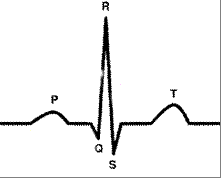
Atherosclerosis, Coronary Plaques, and Heart Rhythm Changes in People with HIV Cardiovascular disease is a growing concern as people with HIV live longer, but the complex relationship between HIV infection itself, immune activation triggered by the virus, and antiretroviral drugs used to treat it remains poorly understood. Three studies presented at the 48th International Conference on Antimicrobial Agents and Chemotherapy (ICAAC 2008) in late October shed further light on factors associated with cardiovascular risk in HIV positive patients. Coronary Plaques Coronary artery disease is increasingly recognized as a potential complication of long-term antiretroviral therapy (ART). The disease is characterized by atherosclerosis, or build-up of plaques and loss of blood vessel elasticity.
Colleen Hadigan and colleagues from the National Institutes of Health performed computed tomography (CT) coronary angiography to measure non-calcified plaque volume and coronary calcium scores in HIV positive and HIV negative individuals. As background, the researchers noted that while several studies have investigated surrogate markers for coronary artery disease, such as carotid artery wall (intima-media) thickness and endothelial function, little data are available on the extent of coronary artery plaques in HIV-infected patients. The present study included 22 HIV positive adults (20 men, 2 women) and 22 HIV negative sex-matched control subjects. The HIV positive patients had been diagnosed with HIV for a mean of 14 years and had been on ART for a mean of 8 years. Overall, they had well-controlled HIV disease, with 77% currently on ART (about one-quarter including a protease inhibitor), 70% with an undetectable viral load, and a mean CD4 count of about 560 cells/mm3. Participants were required to have at least 1 cardiovascular risk factor (e.g., smoking, hypertension, dyslipidemia, diabetes, first degree relative with early coronary artery disease). Framingham cardiovascular risk scores were calculated, revealing that 45% of HIV positive patients and control subjects had a > 10% risk. Results
"The extent of coronary artery plaque appears similar between HIV positive adults and controls with similar degrees of underlying coronary artery disease risk," the investigators concluded. "Among HIV positive patients, however, duration of antiretroviral therapy was more closely associated with plaque volume than traditional markers of coronary artery disease risk such as Framingham risk score. NIAID, CCMD, and NHLBI, National Institutes of Health, Bethesda, MD. Serum Micronutrient Levels In another study, E.L. Falcone and colleagues from Tufts Medical Center looked at the association between serum micronutrient levels and surrogate markers of atherosclerosis in 298 HIV positive adult participants in the Nutrition for Healthy Living cohort. The researchers measured serum selenium, zinc, vitamin A, and vitamin E levels, as well as carotid artery intima-media thickness (cIMT), and coronary artery calcium. They also assessed cardiovascular risk factors, HIV viral load, CD4 cell count, HAART use, cIMT, and coronary artery calcium for each micronutrient tertile (third of the study population). Age, race, smoking history, systolic blood pressure, and blood glucose levels did not differ significantly between the tertiles. Results
"Our study shows that elevated serum vitamin E levels are associated with abnormal early and late surrogate markers of atherosclerosis, and may increase the risk of cardiovascular complications in HIV-infected adults," the researchers concluded. "Studies are needed to determine if HIV-infected adults should be cautioned about the risks of excess vitamin E intake." Tufts Medical Center, Boston, MA. QT Interval Finally, A. Mangli and colleagues, also from Tufts, looked at QT interval as a potential marker of premature atherosclerosis in HIV positive patients. QT interval refers to the distance between the "Q" and "T" segments of an electrocardiogram (EKG) wave (see illustration). Heart rate-corrected QT (QTc) interval has been associated with carotid and coronary disease and mortality in the general population, the investigators noted as background. Further, EKG changes have been demonstrated in HIV positive patients, and certain antiretroviral medications have been linked to prolonged QTc interval. The researchers measured carotid intima media thickness and coronary artery calcium scores in 333 Nutrition for Healthy Living participants. QT interval was measured on resting EKGs and corrected for heart rate using standard equations. Baseline characteristics were assessed for each QTc tertile. Results
Based on these findings, the researchers concluded, "Long QTc is associated with carotid and coronary atherosclerosis in HIV-infected patients and may be useful as a marker of subclinical cardiovascular disease in this population. EKG recordings in all HIV infected patients should be given consideration on a routine basis." Tufts Medical Center, Boston, MA; Tufts Univ. School of Medicine, Boston, MA. 12/5/09 References C Hadigan, l Healey, N Muldoon, and others. Coronary Plaque Volume by CT Angiography Correlates with Duration of Antiretroviral Therapy. 48th International Conference on Antimicrobial Agents and Chemotherapy (ICAAC 2008). Washington, DC. October 25-28, 2008. Abstract H-2311. E L Falcone, A Mangili, and CA Wanke. Serum Micronutrient Levels and Markers of Subclinical Atherosclerosis in HIV-Infected Adults. 48th International Conference on Antimicrobial Agents and Chemotherapy (ICAAC 2008). Washington, DC. October 25-28, 2008. Abstract H-2309. A Mangili, JV Bonnaig, J Gerrior, and others. QT Interval as a Marker of Premature Atherosclerosis in HIV Infected Patients. 48th International Conference on Antimicrobial Agents and Chemotherapy (ICAAC 2008). Washington, DC. October 25-28, 2008. Abstract H-2308. |
The
material posted on HIV and Hepatitis.com about ICAAC 2008 and IDSA 2008 is not
approved by nor is it a part of ICAAC 2008 or IDSA 2008. |
![]()

